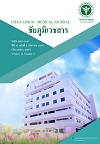Nursing care for diabetic patients with Diabetic Ketoacidosis (DKA) : Case study
Keywords:
Nursing care, Diabetic Ketoacidosis (DKA)Abstract
This research aimed to study the nursing care for diabetic patients with diabetic ketoacidosis (DKA). This was a comparative of 2 case studies who were admitted in the ICU word and 4 relatives, Nakhon Ratchasima Hospital between 25 February – 31 Mach 2020. Data were collected by inpateint medical record, observation and interviews patients and their relatives. Data were analyzed by comparative content analysis of the risk to diabetes with DKA hyperglycemia, sign, symptoms, treatment and nursing problems.
The result of this study found that the nursing care for diabetic patients with diabetic ketoacidosis (DKA) were similar with diabetics type 2 symptoms such as drowsiness, difficulty awakening, breathlessness, don,t speak, and nursing problems found that: 1) Risk of unconsciousness due to the build-up of ketone acids in the body. 2) Hypoxia related to decreased gas exchange due to acidosis. 3) Electrolyte imbalance related to loss of urine due to osmotic diuresis. 4) Inability to communication verbally related to the endotracheal tube. 5) Persons the sick and the relatives were anxious related to critical illness. 6) The routine maintenance plan has changed such as sleep and diet due to critical illness. 7) Risk of accidents due to changes in consciousness level. 8) Risk of malnutrition related to nutrition less than body requirements. 9) Decreased self ability related to critical illness. The difference is Nursing plan number 7 is the loss of contral behavior from Alcohol withdrawal, a factor that may make the disease more severe, take longer to complete treatment, with the length of stay in case 1 in 7 days, in case 2 in 15 day.
Therefore, nurses should focus on nursing care practice for the risk of unconsciousness due to the build-up of ketone acidosis in the body and impaired gas exchange efficiency, which are essential for urgent nursing care. After that, nurses will continue to the nursing care intervention that focus to the patients get wellbeing in daily life effectively.
References
กนกพจน์ จันทร์ภิวัฒน์, สุรพันธ์ พวศ์สุธนะ, กุลธิดา มณีนิล, นิรดา ศิริยากร, ปิยวรรณ เทียนชัยอนันต์. (2563). แนวทางการดูแลผู้ป่วยฉุกเฉินอายุรศาสตร์. กรุงเทพฯ : สำนักพิมพ์กรุงเทพเวชสาร.
โรงพยาบาลเทพรัตน์นครราชสีมา. (2563). สถิติประจำปี 2559-2562. นครราชสีมา : กลุ่มงานการพยาบาลผู้ป่วยหนัก โรงพยาบาลเทพรัตน์นครราชสีมา.
วิจิตรา กุสุมภ์, [บรรณาธิการ]. (2560). การพยาบาลผู้ป่วยภาวะวิกฤต: แบบองค์รวม. พิมพ์ครั้งที่ 6. กรุงเทพฯ : สหประชาพานิชย์.
สุจิตรา ลิ้มอำนวยลาภ, ชวนพิศ ทำนอง. (2557). การพยาบาลผู้ป่วยที่มีภาวะเจ็บป่วยวิกฤต. พิมพ์ครั้งที่ 8. ขอนแก่น: โรงพิมพ์คลังนานาวิทยา.
จิราภรณ์ เดชมา, วนิดา ดุรงค์ฤทธิชัย, วิชุดา กิจธรธรรม. (2556). การศึกษาปัจจัยทำนายภาวะแทรกซ้อนผู้เป็นเบาหวานในชุมชนภายใต้ทฤษฎีการพยาบาลของคิง. วารสารพยาบาลสาธารณสุข, 27(2):63-80.
รื่นจิต เพชรชิต. (2558). พฤติกรรมการดูแลตนเองและการควบคุมระดับน้ำตาลในเลือดของผู้ป่วยโรคเบาหวาน โรงพยาบาลเคียนซา จังหวัดสุราษฎร์ธานี. วารสารเครือข่ายวิทยาลัยพยาบาลและการสาธารณสุขภาคใต้, 2(2):15-28.
สุวรรณี สร้อยสงค์, อังคณา เรือนก้อน, ขวัญสุวีย์ อภิจันทรเมธากุล, นิลุบล นันตา, จุฑามาศ สุขเกษม. (2560). พฤติกรรมการดูแลตนเองตามการรับรู้ของผู้ป่วยเบาหวานชนิดที่ 2 ที่ควบคุมระดับน้ำตาลในเลือดไม่ได้. วารสารวิทยาลัยพยาบาลพระปกเกล้าจันทบุรี, 28(2):93-103.
Downloads
Published
Versions
- 2021-08-17 (3)
- 2021-08-02 (2)
- 2021-02-09 (1)
Issue
Section
License
Copyright (c) 2021 Chaiyaphum Medical Journal : ชัยภูมิเวชสาร

This work is licensed under a Creative Commons Attribution-NonCommercial-NoDerivatives 4.0 International License.





